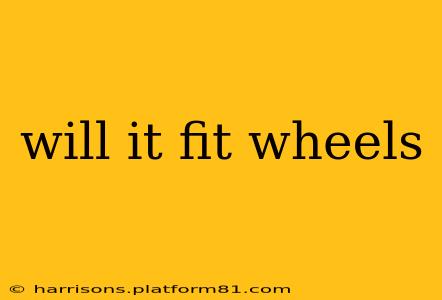Will It Fit? Determining Wheel Compatibility for Your Vehicle
Choosing the right wheels for your car can significantly impact its appearance and performance. However, simply finding a wheel you like isn't enough; ensuring compatibility is crucial. This guide will help you determine if a particular wheel will fit your vehicle, covering key factors and answering common questions.
Understanding Wheel Fitment: The Key Factors
Several crucial specifications determine whether a wheel will fit your car safely and correctly. These include:
-
Bolt Pattern (PCD): This refers to the number of lug nuts and the diameter of the circle they form. It's expressed as a number (number of lugs) x diameter (in millimeters). For example, 5x114.3 means five lug nuts arranged on a circle with a 114.3mm diameter. This is a critical aspect; an incorrect bolt pattern will prevent the wheel from mounting.
-
Wheel Diameter: This is the overall diameter of the wheel, measured in inches (e.g., 17", 18", 19"). This must be compatible with the size specified for your vehicle. Using a wheel with a diameter that's too large or too small can cause clearance issues with suspension components or the wheel well.
-
Wheel Width: Measured in inches, the wheel width influences tire fitment and overall aesthetics. While there's some flexibility, significantly deviating from the manufacturer's recommended width can affect handling, tire wear, and potentially rub against the car's body.
-
Offset: This is the distance between the wheel's mounting surface and its centerline. A positive offset means the mounting surface is closer to the outside of the wheel, while a negative offset means it's closer to the inside. Offset significantly impacts how far the wheel sits inside or outside the wheel well. Incorrect offset can cause clearance problems.
-
Center Bore (CB): This is the diameter of the hole in the center of the wheel that fits over the hub of your vehicle. The center bore should either match your vehicle's hub diameter exactly or be slightly larger (allowing the use of hub-centric rings for a precise fit). A center bore that's too small will prevent the wheel from mounting.
-
Tire Size: While not directly a wheel specification, the tire size is closely linked. You need to select a tire size that's compatible with the wheel's width and diameter. Incorrect tire size can also lead to rubbing issues.
Frequently Asked Questions (FAQs)
What happens if I use the wrong bolt pattern?
Using a wheel with the wrong bolt pattern is extremely dangerous. The wheel will not mount securely, leading to potential wheel detachment while driving – a serious safety hazard.
Can I use a wheel with a different offset?
Using a wheel with a different offset than specified is possible, but it's essential to be aware of the potential consequences. A more positive offset might cause the wheel to sit further inside the wheel well, potentially reducing clearance. A more negative offset might cause the wheel to stick out more, potentially rubbing against the fenders or suspension.
How do I find my vehicle's wheel specifications?
Your vehicle's owner's manual should list the recommended wheel specifications, including bolt pattern, wheel diameter, offset, and center bore. You can also typically find this information on the manufacturer's website or through online wheel fitment guides. Alternatively, you could check the sticker on the driver's side doorjamb (though this sometimes lacks complete information).
What are hub-centric rings?
Hub-centric rings are small metal rings that fill the gap between the wheel's center bore and the vehicle's hub. They ensure the wheel is centered on the hub, leading to a smoother and safer ride. They are often used when the wheel's center bore is slightly larger than the vehicle's hub.
What if my new wheels rub?
If your new wheels rub against the fenders or other parts of your car, you may need to adjust the suspension or use wheel spacers (proceed cautiously; incorrect use of spacers is unsafe). In some cases, you might need to select different wheels with a more appropriate offset or diameter. Never ignore rubbing; it can damage your tires and suspension.
Conclusion:
Choosing the right wheels for your car involves careful consideration of multiple factors. By understanding the key specifications—bolt pattern, wheel diameter, width, offset, center bore, and tire size—you can ensure a safe and proper fit. Always consult your vehicle's owner's manual or a reputable wheel fitment guide for accurate specifications. Remember, safety should always be your top priority.
